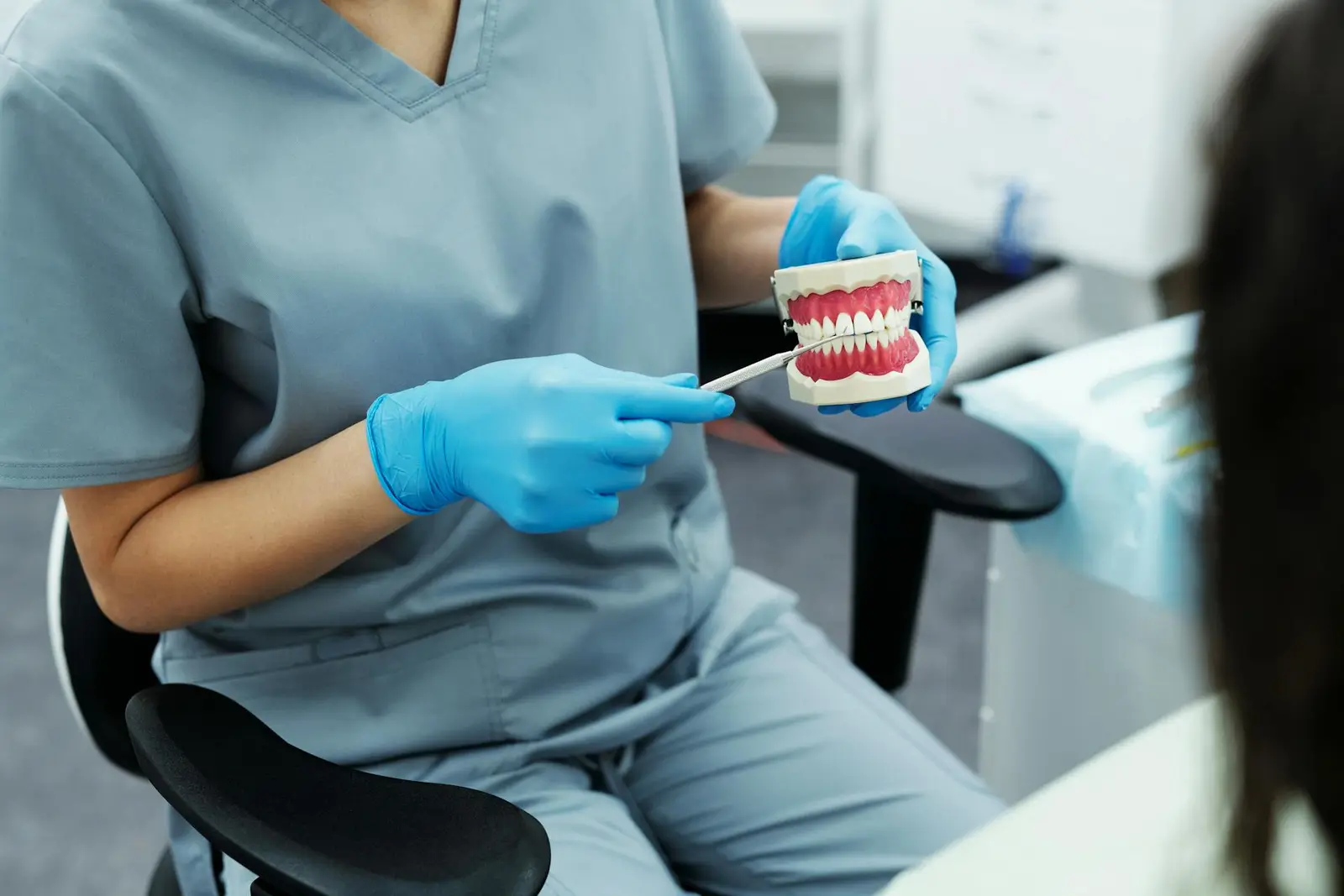Orthodontics
Table of Contents
Key Points
- Orthodontists specialize in the diagnosis and treatment of jaw and tooth misalignments.
- An endodontist is a specialist dentist who focuses exclusively on diagnosing and treating problems that affect the dental pulp and root tissues.
- Both orthodontists and endodontists begin their careers by earning a doctorate in dental surgery (DDS) or dental medicine (DMD) from an accredited dental school.
When people need more specific care than what a general dentist can provide, they are frequently referred to either an orthodontist or an endodontist. If you’re asking, “What’s the difference between an orthodontist and an endodontist?” The answer is in their area of expertise. While they’re both considered a specialist, they have different areas of focus, different training to practice, and their treatments are often significantly different.
An orthodontist dedicates their practice to tooth and jaw alignment, often using things like braces or clear aligners to correct bite misalignments or improve general smile aesthetics. In contrast, an endodontist is a specialist in the tissues contained within the tooth, the dental pulp, and typically performs surgery to remove infections.
Obtaining a referral to the right specialist offers effective and targeted treatment, resulting in faster relief with less discomfort or delays. To help you make the right choice for your needs, we’ll dig into their roles, their education, and what they can typically do to solve dental and oral health issues.
What Is an Orthodontist?
Orthodontists are dentists who have completed dental school, plus another 2 to 3 years of residency focused entirely on tooth movement and facial growth. Orthodontists specialize in the diagnosis and treatment of jaw and tooth misalignments. These misalignments, sometimes called malocclusions, are generally corrected with special appliances like metal or ceramic braces or clear aligning trays.
Orthodontists will usually begin by taking diagnostic records, including panoramic and cephalometric x-rays, digital scans of the teeth and mouth, and conventional photographs. These are crucial records that are then used to help guide a tailored treatment with a goal of moving teeth into proper alignment and achieving a stable, functional bite.
Once the plan has been created and implemented, the orthodontist bonds small brackets to each tooth, which are then wired together, or has a series of custom-fitted aligners created. After this initial fitting, regular adjustments or periodic progress assessments are made, usually every 4 to 8 weeks. These periodic appointments let the orthodontist make small adjustments or wire changes to braces, or issue new aligner trays so that teeth make consistent, gradual movement over time.
Having properly aligned teeth not only improves the overall look of your smile, but it also helps improve oral hygiene in general by making it easier to clean plaque buildup from the tooth surfaces. Effective bite correction can reduce abnormal tooth wear and prevent long-term jaw joint problems. Most orthodontists treat children and adults, covering a wide spectrum of interceptive treatment to comprehensive adult orthodontics, so that everyone has the potential to achieve optimal tooth alignment and oral health.
What Is an Endodontist?
An endodontist is a specialist dentist who focuses exclusively on diagnosing and treating problems that affect the dental pulp and root tissues that are contained within the structure of the tooth. After going through conventional dental school, an endodontist needs to complete an additional 2 to 3 years of residency that emphasizes the biology of the inside of the tooth, root canal anatomy, and surgical techniques that will be used.
Education & Training
Both orthodontists and endodontists begin their careers by earning a doctorate in dental surgery (DDS) or dental medicine (DMD) from an accredited dental school.[1] This comprehensive foundational program covers all the essential elements of general dentistry, including radiology, pharmacology, dental materials, and clinical knowledge and skills. After dental school, dentists choose a specialty and complete 2 or 3 more years of specialized residency training pertinent to their chosen field.
Orthodontist
Orthodontic residents focus on facial growth and development, the biomechanics of physical tooth movement, and the biology of bone remodeling. They learn how to effectively diagnose issues using cephalometric and panoramic X-rays and to create treatment plans for misaligned teeth, bite issues, and jawbone misalignments, such as underbites.
Specialized training that future orthodontists get at this stage includes hands-on experience with the installation of braces, creating retainers, adjusting archwires, and prescribing clear aligners to correct mild to moderate crooked teeth. Residents also closely study growth modification methods, like appliances in children, to help guide jaw development early on.
Endodontist
Endodontic residents devote extensive study to pulp biology, pain management methodology, and oral surgeon techniques. Endodontics training includes advanced study of tooth root canal treatment, irrigation protocols, diagnosis of gum disease and infected teeth, and negotiation of complex root canal systems.
Practical experience residents get additional training in performing endodontic surgery, including apicoectomies, root resection, and the management of traumatic dental injuries. They can also test for optional American Board of Endodontics certification through additional written and oral examinations that show measurable proficiency in diagnostics and treatment.[2]
Similarities Between Orthodontists and Endodontists
Both orthodontists and endodontists typically begin their careers as general dentists, completing a four-year dental school program before earning their chosen DDS or DMD degree. After that, each one also takes an additional 2 to 3 years of residency training, which includes heavy training in diagnostic imaging.[3]
They also both use local anesthesia, and when needed, conscious sedation techniques that ensure patient comfort. Both orthodontists and endodontists collaborate closely with general dentists, as well as other dental specialists.
Common Procedures for Orthodontists and Endodontists
Orthodontic Procedures
- Diagnostic Workup: The process typically begins with an examination and imaging of the teeth and surrounding areas. This helps the orthodontist analyze important jaw and tooth relationships.
- Treatment Planning: The orthodontist then creates a step-by-step plan for moving teeth into their ideal positions, typically with specialized software.
- Appliance Placement: For bracket-and-wire braces, brackets are glued to the teeth, and a wire is bound to them, needing adjustments every few weeks or months. For clear aligners, patients get a set that is often worn for specific durations.
- Monitoring Progress: Throughout the treatment, progress is monitored, and the orthodontist checks movement and makes adjustments as needed.
- Retention Phase: Once alignment is achieved, the brackets are removed, and a retainer is used to help maintain the teeth in their new positions until they are set.
Endodontic Procedures
- Assessment & Diagnosis: Following complaints of pain, the endodontist conducts their exam to assess pulp and nerve health.
- Access & Debridement: Following anesthesia, high-speed and low-speed tools are used to create access to the pulp chamber. The diseased pulp, debris, etc., are all removed with irrigants and disinfectants.
- Canal Shaping & Obturation: Once the canals are cleaned, the endodontist then seals the canal opening.
- Coronal Restoration: Even with a seal on the canal, root therapy typically requires a full-coverage restoration, such as a crown, to protect it long-term.
When to See an Orthodontist vs an Endodontist
If you’re still unsure of whether you may need help from an orthodontist or endodontist, here are some helpful lists of signs that indicate you need one or the other.
Signs You Need an Orthodontist
- Crooked, crowded, or gapped teeth that interfere with chewing or oral hygiene
- Visible bite issues, or bite issues that are causing jaw pain or tooth wear
- Difficulties talking or chewing due to tooth misalignment
- Children losing baby teeth early or late
- The desire to improve smile aesthetics as an adult, or in preparation for other treatments
Signs You Need an Endodontist
- Persistent, severe toothache that feels deep in the tooth, or that throbs
- Intense sensitivity to hot or cold that lingers long after the item is removed or swallowed
- Swelling or excess tenderness in the gums near a specific tooth
- Discoloration or darkening of a tooth with decay or following trauma
- Any bumps on the gums or jaw near a painful tooth indicate an abscess
Leading Orthodontics in Austin
Orthodontists focus on straightening teeth and correcting the bite of your jaw, relying on adjustments from braces or clear aligners to improve both function and aesthetics. Endodontists diagnose and treat infections and diseases of the tooth pulp through root canal therapy and related procedures to preserve your natural teeth as much as possible.
While both specialists complete years of additional advanced training beyond standard dental school and work closely with general dentists to deliver care, they focus on vastly different areas of practice. Speak to your local dental team about a referral to Kunik Orthodontics, or reach out online, to get targeted treatment for your tooth and jaw alignment challenges.
Frequently Asked Questions
Below are some of the most frequently asked questions regarding these two dental specializations
Can an orthodontist perform a root canal?
No. Orthodontists specialize in aligning teeth and jaws, not in removing dental pulp. A root canal must be performed by an endodontist or a general dentist trained in endodontic procedures.
Does an endodontist adjust braces?
No. Endodontists are trained to treat pulp and root issues, not to adjust or place braces. Braces and aligners are managed by orthodontists.
How do I know if I need an orthodontist or an endodontist?
The biggest signs are going to be things like tooth pain that doesn’t go away, sensitivity that impacts your eating habits or daily life, or swelling in your gum tissue. On the other hand, teeth that are crooked, crowded, or gapped, or pain in your jaw without an infection, are reasons you might need an orthodontist.
Get The Smile Of Your Dreams With Austin's Best Orthodontics Team!
We offer orthodontic treatments plans for all ages. Schedule your free consultation now to learn about your options!The Kunik Orthodontics Editorial Guidelines
We prioritize reliability and accuracy by upholding strict editorial standards.
Our commitment to thorough vetting ensures you receive up-to-date and reliable information across every topic in our library. This commitment is driven by our mission to provide superior care and knowledge to all of our orthodontic clients.
By maintaining high standards, we strive to deliver consistent and trustworthy information, offering comprehensive orthodontic care and knowledge to our clients, their families, and anyone searching for accurate information.
Read More About Our ProcessSources
[1]Dental Board of California (n.d.). How to become a licensed dentist. How to Become a Licensed Dentist – Dental Board of California. https://www.dbc.ca.gov/applicants/dentist_licenses_and_permits.shtml
[2]Welcome to the abe case history exam. ABE. (n.d.). https://www.amboardendo.org/
[3]Tanna, N. K., AlMuzaini, A. A. A. Y., & Mupparapu, M. (2021). Imaging in Orthodontics. Dental clinics of North America, 65(3), 623–641. https://pubmed.ncbi.nlm.nih.gov/34051933/
Amanda Stevens is a highly respected figure in the field of medical content writing. Amanda earned a Bachelor of Science degree in Social Work from Purdue University, graduating Magna Cum Laude, which serves as a strong educational foundation for her contributions.

